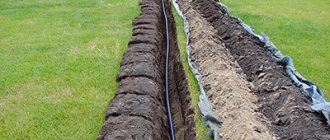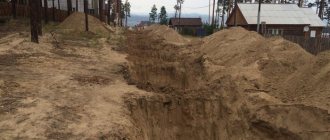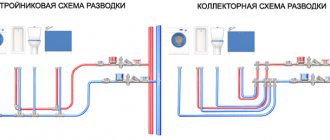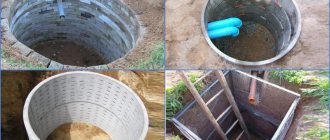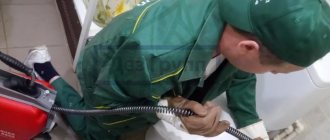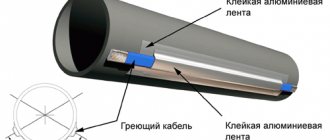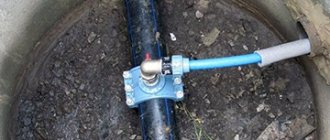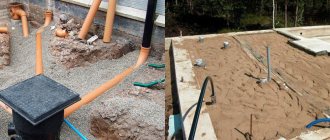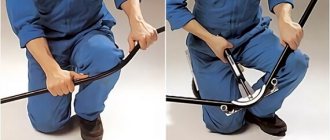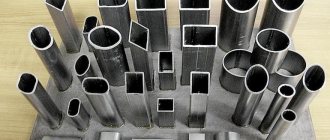Often, in order to lay utilities that involve installing a pipeline, it is necessary to overcome an obstacle such as a road.
This type of work, such as a puncture under the road, is required in cases where it is necessary to install a water supply across the road to a country house or summer cottage. This method allows you to lay pipes of different diameters so that water or gas flows into the house. In addition, a puncture under the road is one of the universal methods of wiring energy cables.
How to make a puncture under the road yourself
Often, in order to lay utilities that involve installing a pipeline, it is necessary to overcome an obstacle such as a road.
This type of work, such as a puncture under the road, is required in cases where it is necessary to install water supply across the road to a country house or summer cottage.
This method allows you to lay pipes of different diameters so that water or gas flows into the house. In addition, a puncture under the road is one of the universal methods of wiring energy cables.
Advantages of the puncture technique
Puncture under the road
One of the most used methods for laying pipes is puncture, used when working in clay and loamy soils (with pipes with a diameter of up to 550 mm). Let us immediately note that the length of the section laid in this way should not be more than 60 meters. In addition, in such a situation you cannot do without special equipment (winches and jacks, in particular).
The use of this method has undoubted advantages, thanks to which it is possible to carry out all the work without destroying the roadway (or any other building structure). Indeed, in this situation, you are laying a pipeline directly under structures or structures located on the surface of the earth.
A prerequisite for the use of this technique is to take into account the main risks associated with the possible shedding (erosion) of soil layers at the site of the pipeline. In all such cases, it is necessary to take into account not only the quality of the earth's composition, but also the depth of groundwater in the area of the proposed installation.
Recently, a method of laying pipes that does not involve digging any trenches has become increasingly popular among builders and is gradually replacing other options for their installation. Experts consider “puncture” the most reliable method and associate this with such advantages as:
- Preservation of the integrity of the area “pierced” by puncturing the soil.
- No threat to communications located in the neighborhood.
- Possibility of refusing special (heavy) construction equipment.
Step-by-step execution of work
First stage.
First you need to dig holes on both sides of the road. Their depth should be equal to the depth of the installed pipe. You need to add another 20 centimeters to this figure to make it convenient to work.
All subsequent work is carried out from the pit. It continues the trench and its length must be no less than the minimum length of the section of prepared pipe, which must be driven into the ground using a sledgehammer.
The receiving pit should have the same dimensions. It should have enough space for comfortable placement. Approximate dimensions may be 60 by 60 centimeters. As a rule, this is quite enough.
Second phase.
Mark the axis of the future hole. To do this, take a steel rod, sharpen it with a grinder, like a pike, and drive it into the ground in the place where the pipe will pass. The length of the rod should not be more than two meters. Otherwise, it will simply bend. Having driven in a section, weld the next one to its end, and repeat these steps until the rod appears in the receiving pit.
The fittings or steel rod indicate the direction for driving the pipe. During work, you may encounter the bar hitting a stone. In this case, you don’t have to take it out of the ground, since this is practically impossible, but simply retreat some distance and start working again.
Third stage.
At this stage we plug the pipe. But before this, you need to make a special nozzle from a larger diameter pipe so that the driven pipe does not flatten.
In addition, the edge of the pipe that will go into the ground must be made sharp using a grinder or even teeth cut into it.
After completing the preparatory work, place the steel pipe on the rod. Then put on the attachment and hit this structure two or three times. After this, remove the nozzle, push a thin plastic tube into the pipe until it stops and turn on the pump. It is best to put a coupling on the tube, with the help of which its diameter will be narrowed in order to increase the pressure of the water flow.
Do not forget to prepare for the fact that all the washed-out soil will flow in the opposite direction, that is, towards you. Therefore, it is better to prepare a pit in advance and install a barrel in it into which all the dirt will drain.
In order for the soil to fall into the barrel, you will need a funnel onto which you need to put a two-meter hose. A funnel can be made from a five-liter bottle by simply cutting off the bottom.
After the receiving barrel is almost completely filled, the pump can be placed in it, but not at the very bottom, but only in the middle. To prevent the pump from breaking, it must be protected with a filter. A small plastic bucket with small diameter holes drilled in it is also suitable as a filter.
Fourth stage.
After washing some of the soil out of the pipe, take the sledgehammer again and repeat the third step. When the entire pipe goes into the soil, you need to weld the next section to it and repeat the entire cycle until the pipe appears on the other side of the road.
When the job is completed, the guide pin will be free of soil. It can be reused, which cannot be said about the pipe that was driven into the ground. It can no longer be used for its intended purpose, since the quality of welding during such work could suffer. Therefore, a steel pipe is used as an insulating casing for a pipe that has a smaller diameter and is made of other materials.
This method has proven effective when using steel pipe with a diameter of 57 millimeters. A PVC pipe for water supply was then installed into it, the diameter of which was 32 millimeters.
Of course, you can use pipes with a larger diameter, but then you will need to either drain the waste water into a prepared trench or install a container with a large volume.
Source
Self-puncture is performed using the following technology
- Along the expected puncture line, the pointed end is driven into the working pit with a sledgehammer into steel reinforcement. It serves as a guide for the pipe and warns of difficult obstacles in its path. The length of the reinforcement rod should not exceed two meters, otherwise the material may be deformed under the blows of a sledgehammer. As it enters the ground, the next section is welded and hammered in again. Work continues until the end appears on the other side of the road;
- On both sides of the road under which communications need to be laid, two pits (pits) are dug symmetrically. The depth of the pits should be slightly greater than the depth of the pipe. The pipe will be driven horizontally through the first pit until it appears on the other side. The dimensions of the working and receiving pit are selected taking into account the above and must provide for the possibility of a person being freely in it;
- Using the same technology, a puncture is made with a pipe placed on the fittings. To prevent the ends from breaking, a nozzle with jagged, sharpened edges is installed in front, and a glass-shaped nozzle is installed at the back. Under the blows of a sledgehammer on the bottom of the glass, the pipe begins to go into the ground. As it moves, the earth becomes compacted in the pipe and movement stops. A jet from the water pump removes it quite easily. Further actions are consistent until the nozzle appears in another pit.
There are various variations of this method:
- Using a bailer made from a large hydraulic cylinder;
- Using a mini horizontal drilling unit or various auxiliary means for driving in reinforcement, for example, a drill;
- Puncture at the pump base.
Having scoured the Internet, we found a thousand and one more ways of “author’s” laying communications underground. We have never doubted the unique abilities of folk craftsmen, but we still recommend that you use one of the methods we propose, since these methods are the most reliable and have a technical basis. It's better not to take risks.
Since the issue of self-piercing is mostly of interest to private property owners who want to either modernize their site or connect communications to it, it is worth remembering that even if the land is on your property, you cannot just take it and drill under it. This is especially true for work that is planned to go beyond private territory. We also note that punctures over 10 meters in length are performed using special equipment and using the HDD method.
How to lay a pipe under a road: technologies are simple, fast and labor-intensive
During the construction of a house and landscaping of a plot, land owners have to solve many problems. Very often, difficulties are associated with laying various communications where there is an almost insurmountable obstacle: for example, a railway track or a roadway. In this case, a natural question arises about how to lay the pipe under the road. There are several methods for solving the puzzle, but the most popular technology remains “puncture under the road.” You can do it yourself, but first it’s better to get acquainted with this method of trenchless installation of communications, and then learn about alternative options.
Features of trenchless laying
The traditional trench method is not the best solution not only for communications laid under the roadway, because:
The trenchless method, in which the coating remains intact, is cost-effective. In addition, master craftsmen are attracted by the accessibility of the method for non-professionals. There are other advantages:
The downside is some costs for special drilling equipment and the personnel who service it. However, the advantages in this case are more significant.
What should be done before laying the pipeline?
Development of the project and its approval is the first stage that the owners must complete. Any construction project must have a detailed, accurate plan for laying communications.
Getting approval
Preliminary coordination with local administration authorities will avoid all problems in the future:
An “amateur” connection to the highway without project approval can lead to the same result.
How to lay a pipe under the road: methods
A direct puncture is not the only way to pass an obstacle without any losses. When laying highways use:
To determine how to lay a pipe under the road and which option to prefer, you need to pay attention to a number of factors. These include:
Another point under consideration is the economic feasibility of using a particular method. Since the main requirement in this case is to preserve the integrity of the road section, more often the choice is made on a “puncture”. This method is gradually replacing all other pipe laying technologies.
The principle of the puncture method
The puncture method is based on pushing steel guides under controlled pressure created by the installation into the ground, followed by gradual expansion of the hole with additional nozzles to the required diameter, while a layer of compacted soil is created around the puncture. The puncture technology does not involve excavation of soil; the hole is pierced rather than drilled or pushed through a hollow pipe (case) from which the soil is excavated outwards.
Return to content
What is a puncture under the road?
Soil puncture is nothing more than punching (pushing) the soil in the horizontal direction. This option guarantees that the integrity of the road surface will not be compromised. In addition, this process does not require excavation of land. It allows you to lay pipes with a diameter of up to 550 mm, so it is equally suitable for laying water, gas, sewerage, and electrical cables under the road surface.
The desire to avoid unnecessary expenses when laying communications is quite reasonable: construction costs are not small, and horizontal drilling using equipment is relatively inexpensive, but it will still take some money. If you do the work yourself, you can achieve significant benefits - from 30 to 40%. The trenchless installation process itself consists of several stages. This:
Due to the work, the soil under the road becomes denser, but the surface itself remains intact. When the road width is large - over 10 m - a special drilling rig designed for HDD is used. A shorter puncture length makes the work much easier, especially if it is done manually.
Advantages of the method
The popularity and demand for this method of laying water pipes is explained by the following advantages:
- Efficiency of work - compared to digging an open trench, puncturing takes 3-4 times less time.
- Low labor intensity - puncturing does not require significant physical effort and a large number of workers, as is the case with the trench method of laying pipes.
- All-season use - piercing the soil for water supply can be done at any time of the year using various installations.
- Environmentally friendly - this method of laying a pipeline avoids disturbance of the soil structure, damage to tree roots, destruction of natural landscapes, artificial lawns and plantings.
- Low risk of damage to nearby communications (sewerage, communication lines, gas pipelines) - when a puncture occurs, the likelihood of damaging nearby communications is much less than when excavating soil with an excavator or trencher.
- Low cost - even when hiring specialists with special equipment, digging a sewer using the puncture method costs 30-40% less than traditional trenching.
How to make a puncture yourself?
As already noted, this manual method is used, but only if the width of the roadway does not exceed 10 m. In this case, the master will need good physical training, but even “Hercules” will not be helped by assistants. Before considering in detail the question of how to lay a pipe under the road, you will have to start looking for equipment, tools and materials.
What will you need to find?
For the operation you need to collect everything you need. The list includes:
You will also need to purchase several pieces of steel pipes of the required diameter.
How to make a puncture with reinforcement?
The process of laying a pipeline manually includes several stages.
After completing the wiring, the trenches and pits are buried, then the soil is thoroughly compacted.
How to lay “pipes with a pipe”?
In this case, you will also need to purchase materials, and you can make the attachment for the working tool yourself. For the puncture you will need:
This technology is also simple, so the stages of difficulty do not promise. First, a tip is made from tool steel and welded to the pipe.
The final operation is cutting off the tip and deformed end of the pipe with a grinder. If they are going to remove it, then this part of the work is done directly during the laying of the pipeline, otherwise a collapse is possible.
Help from a hand drill
This is another, relatively simple option for those who are not satisfied with the previous methods. In this case, the master will need to purchase a two-meter hand drill: a meter of tool plus a meter of extension. You will also need:
The work looks like this step by step:
If the soil under the road is not too pliable, then it is recommended to make a small excavation from the exit trench in advance, and then securely strengthen it with boards. When the soil at the work site is rocky, obstacles may arise that will have to be heroically overcome.
Necessary equipment
Mini HDD - device diagram
Equipment for horizontal drilling is quite expensive. But if there is no financial opportunity to purchase such equipment, then you can make a mini HDD with your own hands. This idea is quite feasible, as our craftsmen have repeatedly demonstrated by showing their HDD installations at various forums.
The manufactured equipment is ideal for domestic purposes, as it allows you to perform horizontal drilling with your own hands of any complexity.
For example, when working with pipelines, it is often necessary to make a horizontal move. This process is quite complicated, and only a physically strong person can perform it.
To perform drilling you will need:
- Medium and high power welding machine (inverters can be used, but their frequency power is low).
- A grinder or grinder with 180 or 230 mm discs, and it must be two-handed.
- The consumption of disks will be quite large, so you need to purchase more of them.
- Sledgehammer.
- Reinforcement Ø from 20 mm and a length of 10 cm longer than the hole being drilled and steel pipes of the same length.
- Pump with hose.
- Tub with a volume of 150 l. (recommend larger ones) with a wide neck.
- Drill (can be made by hand).
- Funnel with a hose 2 m long.
Horizontal directional drilling method
When the width of the road surface exceeds 10 meters, it is better to use another technology - horizontal directional drilling, or HDD for short. The maximum pipe diameter for this operation is 1200 mm, but private developers do not need such figures. It is possible to lay any highways - both metal and plastic. For horizontal directional drilling, the master will need a special drilling rig designed for this job.
It is installed in the place on the side of the road where the entrance to the pipeline route will be located under the road. To drill a hole, a monitor and locators are used: this equipment will make it possible to avoid even minimal deviations from the given trajectory. HDD is a method that is used to lay communications under any (artificial, natural) objects, at any depth.
Laying a pipeline using a drilling rig also consists of several stages.
The last stage is stretching the pipeline. To do this, attach a nozzle with a swivel to the pipe using a hinged earring, which will prevent rotation of the element. The other end of the swivel is connected to the rimmer, after which the pipeline is pulled into the well.
Yes, this is a possible alternative, but it will require additional investment. If anyone is wondering how much it will cost to rent equipment, they say that “hiring” the installation along with the staff will cost on average 1000-1400 rubles per hour. Prices, of course, can rise.
Cost of work
The price per meter of puncture of the soil layer under an obstacle for laying a water pipe depends not so much on the volume of work, the type of soil, but on the length and diameter of the channel being punched. Thus, laying 1 meter of water pipe using horizontal directional drilling will cost the customer on average 1300 -1600 rubles. When installing water supply pipes under roads, buildings and other obstacles using horizontal drilling, hydraulic or vibration puncture, the cost of 1 meter will be slightly lower - from 1000 to 1200 rubles.
Auger drilling
This is another answer to the question of how to lay a pipe under the road. In this case, the hydraulic unit acts as the main working unit. This trenchless pipeline installation differs from the previous method.
Pipes or cases are immediately installed inside the tunnel. The maximum diameter of such holes is 1720 mm.
Techniques for laying pipeline lines
Types of trenchless laying
Among all the known methods of laying pipe lines, the following are most widespread:
- direct puncture;
- so-called “pushing” of the soil;
- drilling (horizontal);
- penetration using shields.
In order to choose the appropriate pipe laying option, you will need to decide on the following things:
- the condition of the soil in the wiring area (including the presence of natural waters in it);
- the nature of the development;
- parameters of isolation of the laid channel from external factors;
- length of laying;
- pipeline diameter;
- economic justification for this particular installation method.
Other pipe routing methods
There are 2 more types of equipment that can be used depending on the characteristics of the soil.
Both options are worth considering as they are effective and promise minimal time wastage. And serious savings, since even if you rent equipment and invite specialists, the puncture will cost less. They say that the difference can be very noticeable - from 30 to 40%.
Does it make sense to do the work yourself?
Before making a final decision on how to lay a pipe under the road, you need to think about the feasibility of this undertaking. If the tunnel is more than 10 meters long, then in this case it is better to avoid the “feat”, since the process will take a lot of time and effort.
The same conclusion can be drawn if there are other underground communications on the site, or if there are difficult-to-pass areas on the territory. Soft soil (sandy, clay) will simplify the task somewhat, but you need to know well not only your site, but also all the features of the stages.
Do-it-yourself piercing can be considered if:
If you have any doubts about your own abilities, and the preparatory work, which may take several weeks, is not inspiring, then it is better to turn to professionals. They will complete the task in a few days. A 100% guarantee of the safety of the road surface and route is another advantage; it still cannot be provided by independent work.
How to lay a pipe under the road? It’s not easy if the master and his assistants chose thankless manual labor and the same tools. It’s easy and fast if most of the work is done by special equipment and professionals. Many craftsmen who decide to make a gasket without the help of equipment encounter unexpected problems. Therefore, it seems that it makes sense to donate a small amount (1000-1500 rubles), but at least avoid unnecessary headaches.
Types of punctures
Depending on the mechanisms used and the principle of laying a channel for laying pipes, the following types of puncture are distinguished:
For convenience of work, two pits (pits) are dug at opposite ends of the path of the pipe being laid - the initial and final.
Punching
This type of puncture is performed as follows:
When laying a polyethylene water pipe in winter, during the pulling phase, it is heated with a blowtorch or torch. This is necessary so that the polyethylene becomes more flexible, does not crack or deform when passing through the channel drilled for it.
Horizontal directional drilling
This method is widely used when laying water supply networks with a diameter of up to 200 mm.
The puncture is carried out by special self-propelled units on caterpillar tracks, capable of working in conditions of limited space and marshy soil. The technology for performing horizontal directional drilling consists of the following stages:
The size (diameter) of the rimmer and expanded well should be 30 mm larger than the diameter of the pipe that is placed in it.
During the work process, a special composition is supplied inside the drill string rods and to the tip (working head), which helps to destroy the rock being drilled, reduce the friction of the rods on the soil, and remove the drilled rock from the well. After completion of the work, the drilling mixture collected in the pit is pumped out, cleaned of rock particles and regenerated with the help of chemical reagents for subsequent use.
Auger drilling
This method of trenchless laying of water supply and other communications is as follows:
Several water supply lines are placed into a pipe drilled in this way.
Hydropuncture
This type of puncture is performed using a horizontal drilling installation, in which a special head is placed at the end of the first rod of the drill string, piercing the soil layer in front of it using a powerful jet of water created by a centrifugal pump.
This method is used to puncture loose sandy and sandy loam soils.
Vibration puncture
During vibration puncture, the working body of the pneumatic punch, in addition to rotational movements, also performs powerful reciprocating movements (like a jackhammer). Thanks to this, such installations can quickly and efficiently pierce even the densest clay or loamy soil.
Subtleties of choosing the appropriate method
The method of laying communications using horizontal drilling is chosen at the design stage of a specific process. If trenchless pipe laying is carried out as part of the construction of a facility, for example, a residential building, then the work may become part of the overall construction project.
When designing, the following information is taken into account:
- the length of communications that need to be laid using a trenchless method;
- diameter of the case or pipe;
- the material from which the communications are made;
- the depth to which the pipes must be laid;
- type of pipeline (pressure or non-pressure);
- the ability to install starting and finishing pits of suitable depth;
- access roads to the work site;
- the presence of a sufficiently spacious area for storing materials, equipment, etc.;
- groundwater level;
- other geological features of the site;
- a plan for the location of communications already available on the site.
During the construction process, it is sometimes necessary to change an already drawn up project. This may be due to the desire to reduce costs by using, for example, plastic pipes instead of steel. In addition, the plan for the location of underground communications at the site is not always sufficiently accurate.
The diameter of the pipe is one of the indicators that is taken into account when choosing methods for trenchless installation of communications. The well should be a little larger
When performing work, such unaccounted for pipes or cables may be discovered. All these points may require changes in the project, and this may affect the decision on the drilling method.
If the depth of laying communications is small, there is a danger of subsidence of the top layer of soil, especially if bentonite solution was used during drilling. In such cases, it is better to give preference to horizontal auger drilling.
Very often, the drilling method is determined by what kind of equipment is available to the organization carrying out the order.
For example, if builders have jacks or an installation for horizontal directional drilling, then this will be preferred over the puncture method. Most often, such changes are dictated by considerations of economic benefit.
Puncture under the water supply with your own hands step by step
You can make a puncture underground for a water supply yourself, without involving specialists and contractors, if its length is no more than 30 m. Such work, with the exception of purchasing materials, will not cost the performer a penny, allowing you not only to save money, but also to gain useful experience in laying communications puncture.
Materials and tools
When piercing a road for a water supply with your own hands, the only materials needed are a thick-walled steel pipe with a diameter of 40 mm with a welded sharp tip of a pyramidal or conical shape. It is better to make such a working body from durable tool steel - a fragile material, when encountered in the soil with solid inclusions and layers of clay, can quickly fail by becoming deformed.
The tools for this work will be required:
Piercing stages
A simple puncture technology under a road or other obstacle consists of the following steps:
The pipe is removed from the puncture directly when laying a water pipeline into it, so that the earth around the made channel does not collapse and fill it up.
In what cases can a puncture be done independently?
- You have an understanding of the issue, technical, engineering, construction education. You know the risks of laying communications yourself, but you also know what to do if something goes wrong.
- The authorities have given permission to carry out work on your site and approved the project.
- You have remarkable physical strength
- You have a set of necessary tools in stock: at least a winch, a jack, an angle grinder and a welding tool.
- You like to do everything yourself
- Do you want to save on laying underground communications?
- The length of your puncture is no more than 10 meters long.
- You are confident in the nature of the soil in your area: the tool will not bump into stones when drilling, and after the work is completed, the soil will not sag or collapse.
- Getting communications down quickly is not your main goal. You can spend time studying the technology, choosing the best and most suitable pipe for you.
- You are confident in your abilities and have an economic justification for the installation method you have chosen.
